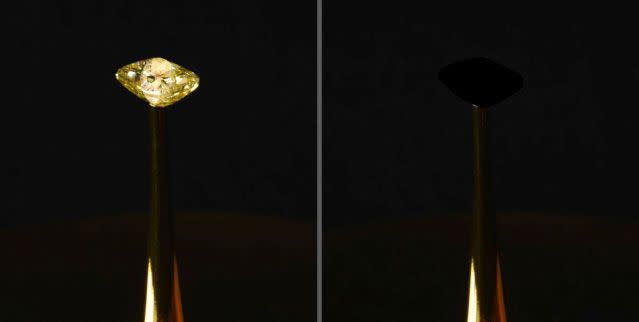Scientists Create the Blackest Material Ever

There's a new "blackest black," and it's making its public debut in an art exhibition being held at the New York Stock Exchange.
Titled "The Redemption of Vanity," the project coats a multi-million dollar diamond in the black material, taking away all shine and color.
The project continues a debate within the art world about who is allowed to use materials with superlatives like "blackest black" or "pinkest pink."
Once scientists create the blackest black material ever seen, what do they do with it? Go on tour. After generating carbon nanotubes (CNTs) into a new material that is capable of capturing 99.996 percent of incoming light, MIT scientists are showing the material's abilities at an art show with the help of a multi-million dollar diamond and the New York Stock Exchange.
Titled "The Redemption of Vanity,” the art exhibition has the semblance of a magic trick. Coated with the CNT material, a shiny 16.78-carat natural yellow diamond valued at $2 million becomes a black void. The exhibition opened on September 13 and will last at the Stock Exchange through November 25.
The project is a collaboration between artist Diemut Strebe and MIT scientist Brian Wardle and his lab, who created the material.
“Any object covered with this CNT material loses all its plasticity and appears entirely flat, abbreviated/reduced to a black silhouette,” Strebe explains in a press statement. “In outright contradiction to this we see that a diamond, while made of the very same element (carbon) performs the most intense reflection of light on earth. Because of the extremely high light absorptive qualities of the CNTs, any object, in this case a large diamond coated with CNT’s, becomes a kind of black hole absent of shadows. The unification of extreme opposites in one object and the particular aesthetic features of the CNTs caught my imagination for this art project
Strebe is no stranger to scientifically based art. She's the Ida Ely Rubin Artist in Residence at the MIT Center for Art, Science & Technology, and has collaborated with a number of MIT labs before. Here, her project turns a well-known and valued object into something completely alien.
“The project explores material and immaterial value attached to objects and concepts in reference to luxury, society and to art,” Strebe says in the statement. “We are presenting the literal devaluation of a diamond, which is highly symbolic and of high economic value. It presents a challenge to art market mechanisms on the one hand, while expressing at the same time questions of the value of art in a broader way. In this sense it manifests an inquiry into the significance of the value of objects of art and the art market.”
Together, both Wardle and Strebe say they "do not believe in exclusive ownership of any material or idea for any artwork and have opened our method to any artist." While there's no specifics about how other artists could use the work, the statement is a protest against the actions of another artist, Anish Kapoor.
Kapoor, a British sculptor, has worked with a superlative material called VantaBlack, which is one of the darkest and least-reflective substances ever created. Kapoor has signed an exclusive license to use the material artistically, which generated backlash from both the artistic and scientific communities. One scientist even created a "pinkest pink" and then banned Kapoor from using it, although he was able to find it eventually.
On Strebe's MIT page, she notes the "project can also be interpreted as a statement against British artist Anish Kapoor’s purchase of exclusive rights to a formula of carbon nanotubes as a material for artworks."
The material isn't solely meant for artistic projects (or feuds). Wardle sees other uses for the material in astronomy, where it could assist space telescopes discover exoplanets.
"There are optical and space science applications for very black materials, and of course, artists have been interested in black, going back well before the Renaissance," Wardle says. "Our material is 10 times blacker than anything that's ever been reported, but I think the blackest black is a constantly moving target. Someone will find a blacker material, and eventually we'll understand all the underlying mechanisms, and will be able to properly engineer the ultimate black."
You Might Also Like
